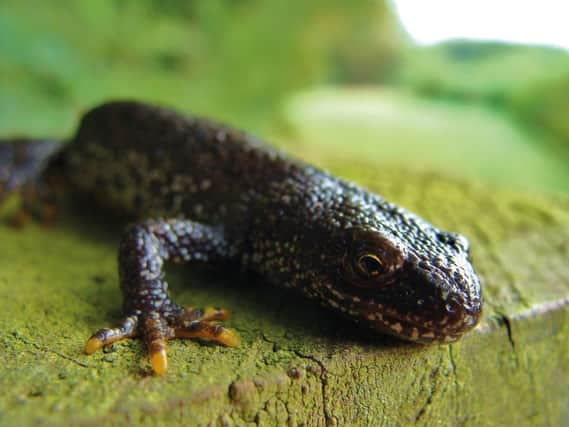New project to halt decline in great crested newt numbers gets underway with Yorkshire Wildlife Trust and Yorkshire Amphibian and Reptile Group


The YWT has become the official habitat delivery body for north east and north west Yorkshire specialising in pond creation and restoration. Funded through great crested newt district level licencing, along with members of Yorkshire Amphibian and Reptile Group (YARG), the YWT carried out its first breeding pond survey of the season in West Yorkshire last month.
We started our survey sharing out equipment and disinfecting wellies for biosecurity, while our licenced leaders and surveyors, Clare and Andy from YARG, give an overview of what is on the cards for our first survey.
Advertisement
Hide AdAdvertisement
Hide AdThe chances of success and sightings are high as we walk through the kissing gate and down the muddy track to pond one just a short walk away.
Great crested newts are identified by their warty or granular skin, often dark brown or black – especially when on land – with dark spots. The underside ranges from yellow to orange with an irregular pattern of dark or black blotches, which extends in females all the way to the tip of the tail. However, it is the iconic and majestic jagged back crest, with smoother tail crest and iridescent stripe, seen only on the males during breeding season, that is the real show-stopper.
Widely distributed across Britain, but absent from Ireland, great crested newt numbers have declined over the last six decades, despite their fully protected status under law. This is mainly due to a mix of habitat loss and fragmentation, infilling of ponds and increased pollution.
It is illegal to capture, kill, disturb or injure great crested newts and anything that may cause this is strictly controlled, with activities being regulated and carried out under the watchful eyes of licenced and experienced individuals.
Advertisement
Hide AdAdvertisement
Hide AdWe began with brief figure of eight sweep net surveying in the first pond, kept to a minimum due to its potentially destructive nature if carried out too vigorously. This is then followed by an egg search.
Disappointingly, both yield nothing. Next up is the bottle trapping, where reclaimed plastic drink bottles with the top removed and replaced the wrong way around are used to create a trap which is then secured by a cane around the pond edge.
We insert seven into the pond at two-metre intervals pointing downwards, just below the water level.
Dependent on location and temperature, great crested newts generally emerge from their overwintering sites in March or April and move into their breeding ponds which tend to be medium to large (150sq m to 1000sq m) with a maximum central depth of one metre.
Advertisement
Hide AdAdvertisement
Hide AdThe males enter first and have elaborate courtship rituals involving rocking, whipping, tail-whipping and fanning. They are territorial, often defending favoured spots preferring open, deeper water for display. With key territory often being so highly prized, males are known to even mimic females to lure other males away from the top spots so they can claim them as their own.
The female’s eggs (potentially up to 250 per newt per season) are then laid in the softer vegetation at the ponds’ edges, where they are carefully wrapped or double folded for protection.
Approximately two to four weeks later, the larvae will hatch and develop feathery gills on the head which is a key distinguishing feature from tadpoles. After a couple of months, the front legs grow, following shortly by the back.
Once the gills have been fully absorbed (normally by late summer), the new newts move on to land, feast on insects and prepare for the winter in their terrestrial habitat of loose rocks, soil and timber.
Advertisement
Hide AdAdvertisement
Hide AdOn arrival at pond two, the egg search quickly begins. Almost instantly we find something: a jelly-like egg folded in a soft willow herb leaf only around 5mm wide. There are more here too.
These are clearly different to smooth and palmate newt eggs which are smaller and a grey or off-white colour. We put a further 24 bottle traps in this pond.
About an hour after sunset, and after a visit from some common pipistrelle bats foraging over the trees and pond, we begin searching using high-powered torches into the world under the water. A quick flick of a tail and some disturbed sediment suggests newt activity, but no positive identification.
Suddenly, the light from my torch bounces off the silvery flash of a tail – a male great crested newt! He digs his feet into the sediment as he stakes out his territory, and then he is gone.
Advertisement
Hide AdAdvertisement
Hide AdThe briefest but most rewarding encounter for an evening’s toil.
At the end of the survey, we have counted a total of four great crested newts, four smooth newts and a common frog. These are relatively small numbers but it is still early in the season.
Survey methodologies are being constantly refined and with the advent of eDNA (Environmental DNA released into the environment via faeces, shed skin, mucous etc) it’s now even easier to identify newt presence or absence.
Still, nothing beats a first-hand wildlife encounter like this.